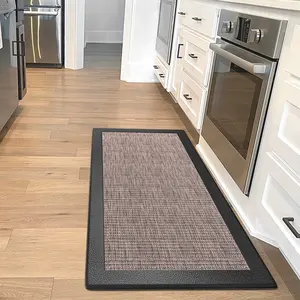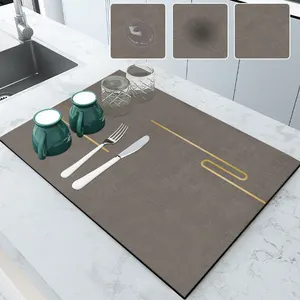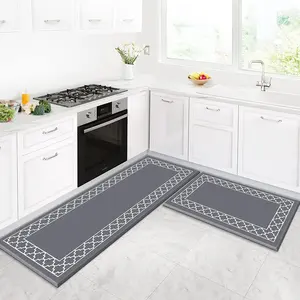Introduction
The kitchen, often the heart of the home, is a place where functionality and comfort are paramount. While we often focus on appliances and layout, there's an overlooked element that can significantly enhance your kitchen experience - ergonomic foam kitchen mats. These mats, designed with the principles of ergonomics, prioritize user health, comfort, and efficiency. They can reduce physical strain, improve posture, and make your time in the kitchen more enjoyable. This article delves into the science of ergonomics, the benefits of ergonomic foam kitchen mats, and how to choose the right one for your kitchen.
Understanding Ergonomics and Its Importance in the Kitchen
Ergonomics is a science that focuses on designing and arranging products to prioritize user health, comfort, and efficiency. While often applied to workplaces, it's equally important in home settings, especially the kitchen. An ergonomically designed kitchen reduces physical strain and enhances efficiency by minimizing movements required for daily tasks and ensuring easy accessibility. This concept is crucial in kitchen design as it can make tasks less time-consuming and more enjoyable, reducing the risk of postural symptoms and aches.
What are Ergonomic Foam Kitchen Mats?
Ergonomic foam kitchen mats, similar to anti-fatigue mats, are designed to reduce fatigue caused by standing for long periods on hard surfaces, such as kitchen floors. These mats can be made of various materials, including foam, which provides excellent cushioning. They are often used to decrease foot and lower limb discomfort for individuals who stand in one position for extended periods, such as while cooking or washing dishes. However, the use of these mats should be combined with proper footwear and flooring for optimal comfort and fatigue reduction.
Benefits of Using Ergonomic Foam Kitchen Mats
Ergonomic foam kitchen mats, similar to anti-fatigue mats, can significantly improve comfort and reduce fatigue. When standing for long periods, blood flow to the lower extremities can be restricted, causing soreness and fatigue. Ergonomic mats provide support to muscles in the lower legs and back, promoting subtle movement in the leg and calf muscles, which results in increased blood and oxygen flow. This can enhance productivity and reduce the likelihood of muscle strains and joint pain. Therefore, implementing ergonomic solutions like foam kitchen mats can transform your kitchen experience.
How Ergonomic Foam Kitchen Mats Improve Posture
High-quality anti-fatigue kitchen sink mats provide thick, cushioned support to help improve circulation and posture, ensuring that you can stand comfortably while working in the kitchen or at any work station. This is perfect for anyone who stands for long periods of time. The standing desk mat measures 30” (L) x 20” (W) x 0.5”(H), providing an extra large activity area in laundry room, kitchen, office or any other high-traffic place. The neutral color matches any décor, making it a great gift for those who value health and well-being.
Reducing Fatigue and Discomfort with Ergonomic Foam Kitchen Mats
Ergonomic foam kitchen mats are designed to alleviate discomfort and reduce fatigue caused by standing for extended periods. These mats are made from high-density foam that offers support and pressure relief, making them ideal for use in the kitchen. As pointed out by pain management specialists, the right balance of elasticity and firmness in a mat can prevent overcompensation and strain, further reducing discomfort and fatigue.
Enhancing Safety in the Kitchen with Ergonomic Foam Mats
Quality kitchen mats enhance safety in the kitchen with their non-slip bottom, ensuring the mat stays in place for added stability. This anti-fatigue foam mat can be used on various floor surfaces. It also features a slow-rebound property that protects dishes from breaking if dropped while cleaning or cooking. This mat is a must-have for those standing for extended periods in the kitchen.
Choosing the Right Ergonomic Foam Kitchen Mat
When shopping for an ergonomic foam kitchen mat, consider its size, shape, and thickness. The mat should fit your space without creating a tripping hazard or impeding walkways. It should be large enough to support your body as you work, but not so large that it gets in the way. The thickness of the mat is crucial in determining its effectiveness in alleviating stress on your joints, feet, and back. Mats about 3/4 of an inch thick offer enough support without making you feel like you’re standing on a platform. Overly soft or thin mats may not serve their intended purpose of alleviating fatigue and stress.
Considerations for Size and Shape
Choosing the right size and shape for your ergonomic foam kitchen mat depends on your kitchen layout and the specific area you want to cover. Standard sizes like 2x3 and 3x5 are common for areas in front of sinks and stoves. For larger spaces, consider sizes like 5x7, 6x9, or even 8x10. Runner mats are ideal for narrow kitchens or those with an island. Ensure the mat size you choose doesn't exceed the kitchen's length and leaves some space between the mat and the cabinetry.
Material and Durability Factors
The material of an anti-fatigue kitchen mat greatly influences its support and contouring capabilities. Most mats are made from foam, rubber, gel, or a combination of these. Foam and gel provide cushioning, while rubber mats are firmer. High-density foam mats offer support and pressure relief. Some mats use closed-cell nitrile rubber for pressure alleviation. Others combine shock-absorbing gel cushion and energy-return foam core for optimal support. Material choice is crucial for durability and effectiveness of the mat.
Aesthetic and Design Preferences
When it comes to aesthetic and design preferences, kitchen rugs offer a plethora of options. You can opt for vintage rugs to add a touch of nostalgia or go full circle with round rugs for a modern twist. Play with patterns or show off a bold pattern to make a statement. If you prefer a more natural look, consider rugs that weave in natural textures. You can also define the room with runners or even double up on rugs for a layered look. Remember, your rug should not only be functional but also complement your kitchen's overall decor.
How to Maintain and Clean Your Ergonomic Foam Kitchen Mat
Maintaining and cleaning your ergonomic foam kitchen mat is crucial for its longevity. Avoid standing on the mat with sharp heels and don't clean it with a power vacuum cleaner. Only use mild soap and water for cleaning. Avoid using hot water extraction, steam cleaning, or high pressure water/air. Do not fold or roll the mat as it can cause permanent damage. Ensure that no water or moisture gets trapped under the mat as it can lead to mold or mildew. Regularly check under your mat and ensure your floor is completely dry before placing the mat back.
Conclusion
Ergonomic foam kitchen mats are a simple yet effective solution to enhance comfort, reduce fatigue, and improve safety in your kitchen. They are designed to support your body, promote better posture, and reduce the strain of standing for extended periods. When choosing a mat, consider factors such as size, shape, thickness, material, and aesthetics to ensure it fits your space and meets your needs. With proper care and maintenance, these mats can serve you well for years, transforming your kitchen experience. Remember, a comfortable kitchen is a happy kitchen.








































 浙公网安备 33010002000092号
浙公网安备 33010002000092号 浙B2-20120091-4
浙B2-20120091-4